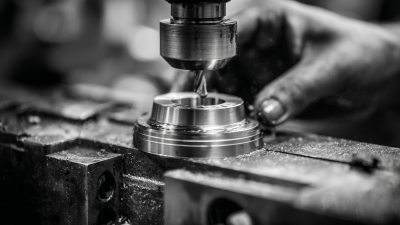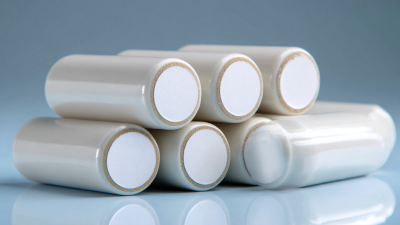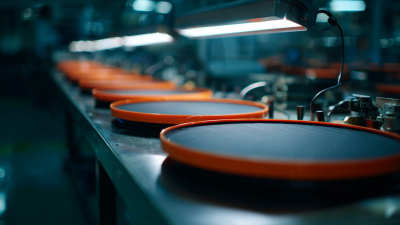Revolutionizing Automation with Advanced Gripper End Effectors for Seamless Operations
Table of Contents
- Understanding the Role of Advanced Gripper End Effectors in Automation
- Key Features to Look for in Modern Gripper Technologies
- Integrating Gripper End Effectors with Robotic Systems for Efficiency
- Tips for Selecting the Right Gripper for Your Automation Needs
- Future Trends in Gripper Technology and Their Impact on Automation
- Case Studies: Successful Implementations of Advanced Gripper Solutions
- FAQS
- Conclusion
- Related Posts
The integration of advanced Gripper End Effectors is transforming the landscape of automation across various industries, significantly enhancing operational efficiency and precision. According to a recent report by MarketsandMarkets, the global market for automation components, including end effectors, is projected to reach $12.4 billion by 2025, reflecting an annual growth rate of 10.5% due to increased demand for automation in manufacturing and logistics. ST.CERA CO., LTD., as a leading high-tech enterprise specializing in precision ceramic manufacturing, is well-positioned to leverage this trend. With a team of top-ranking experts and engineers in precision ceramic manufacturing, ST.CERA CO., LTD. focuses on innovative research and development that contributes to the advancement of Gripper End Effectors, ensuring seamless operations that meet the ever-evolving demands of the automation industry.

Understanding the Role of Advanced Gripper End Effectors in Automation
The evolution of automation technology has significantly transformed the landscape of various industries, particularly with the introduction of advanced gripper end effectors. These innovative tools play a crucial role in enhancing operational efficiency by enabling seamless interaction between robots and their environments. Recent advancements, such as compact vacuum generators, illustrate the ongoing developments that make end effectors more versatile and effective in handling diverse tasks. With applications ranging from simple packaging to complex bioscientific workflows, the adaptability of these tools is vital in meeting the specific needs of automation processes.
Furthermore, the growing market for electric grippers projected to reach USD 3.32 billion by 2034 reflects a surge in demand for sophisticated automation solutions across sectors. As manufacturers focus on integrating advanced gripper mechanisms—such as soft and multi-finger designs—automation becomes increasingly capable of managing delicate and intricate tasks. This shift not only aids in addressing the challenges faced in industries like food handling and agriculture but also pushes the boundaries of what's possible in robotics, paving the way for more adaptive and intelligent systems in the future.
Revolutionizing Automation with Advanced Gripper End Effectors for Seamless Operations
| Dimension | Description | Impact on Automation |
|---|---|---|
| Grip Strength | The force applied by the gripper to hold an object securely. | Enhances the ability to handle heavier or fragile items. |
| Versatility | Ability to adapt to different shapes and sizes of objects. | Improves workflow efficiency by reducing the need for specialized tools. |
| Speed | The rate at which the gripper can open and close. | Increases throughput and productivity in automated processes. |
| Sensor Integration | Incorporation of sensors to provide feedback on grip and position. | Enhances precision and reduces errors in handling tasks. |
| Material Composition | The materials used in the construction of the gripper. | Affects durability and suitability for different environments. |
Key Features to Look for in Modern Gripper Technologies
In the rapidly evolving landscape of automation, the significance of advanced gripper end effectors cannot be overstated. These essential components are the backbone of efficient robotic systems, allowing for precise manipulation of various objects. When investing in modern gripper technologies, it is vital to look for features that enhance functionality and adaptability. According to a recent industry report by Markets and Markets, the global robotic gripper market is projected to reach $4.3 billion by 2025, reflecting the growing demand for innovative solutions.
Key features to consider include versatility, enabling grippers to handle a wide range of shapes and sizes; sensitivity, allowing for delicate handling of fragile items; and connectivity, ensuring seamless integration with existing automation systems. Additionally, advanced gripping technologies such as soft robotics and suction technologies can significantly improve performance in diverse applications, from warehousing to food processing.
Tips: When selecting a gripper, prioritize modular designs that can be easily reconfigured for different tasks. Furthermore, consider the importance of feedback mechanisms; these enhance the precision of handling delicate items, ultimately improving throughput and reducing damage rates. Emphasizing these features not only streamlines operations but also aligns with the industry's shift toward more flexible, intelligent automation solutions.
Integrating Gripper End Effectors with Robotic Systems for Efficiency
The integration of advanced gripper end effectors with robotic systems has marked a significant milestone in the field of automation. These sophisticated tools are designed to enhance the efficiency and versatility of robots, enabling them to perform complex tasks with precision and reliability. By incorporating adaptive gripping technologies, these end effectors can easily handle a diverse range of materials and shapes, making them ideal for various applications in manufacturing, logistics, and assembly lines.

Moreover, the seamless operation between robotic systems and gripper end effectors streamlines workflows and reduces downtime. With real-time feedback and advanced sensing capabilities, these systems can adjust their grip strength and positioning dynamically, ensuring safe handling of delicate items or heavy parts alike. The synergy created by this integration not only boosts productivity but also opens up new possibilities for automation in previously challenging environments, paving the way for innovative solutions in industries such as healthcare, food processing, and beyond.
Tips for Selecting the Right Gripper for Your Automation Needs
When selecting the right gripper for automation needs, it's essential to consider the specific application requirements and the type of materials being handled. According to a recent report by MarketsandMarkets, the robotic gripper market is projected to reach $3.7 billion by 2025, growing at a CAGR of 12.5%. This growth is driven by the demand for increased efficiency and precision in manufacturing processes. Choosing the appropriate gripper can significantly enhance the productivity and safety of robotic systems, as various types, including mechanical, vacuum, and magnetic grippers, offer distinct advantages based on the handling task.
Evaluating factors such as payload capacity, speed, and adaptability is crucial in the selection process. For instance, a study by The Robot Report emphasizes the importance of flexibility in a gripper’s design to accommodate different object shapes and sizes without compromising speed. Additionally, integrating advanced technologies, such as AI and machine learning, can further refine the selection process, leading to improved decision-making and operational outcomes. Adapting the right gripper not only streamlines production but can also lead to significant cost savings, highlighting the necessity of making informed choices in the evolving landscape of automation.

Future Trends in Gripper Technology and Their Impact on Automation
The future of automation is being significantly shaped by advancements in gripper technology, which play a critical role in robotic applications across various industries. According to a report by MarketsandMarkets, the global robotic gripper market is projected to reach $3.8 billion by 2026, growing at a CAGR of 11.7% from 2021. This surge is driven by the increasing demand for automation in manufacturing processes, particularly in sectors such as automotive, electronics, and food and beverage. Advanced gripper end effectors are designed to handle a broader range of objects and incorporate cutting-edge technologies such as artificial intelligence and machine learning, enhancing their efficiency and adaptability.
Emerging trends in gripper technology include the integration of soft robotics, which enables safer interactions with delicate items and versatility in handling irregular shapes. A study by the International Federation of Robotics highlights that collaborative robots, or cobots, are becoming increasingly prevalent in industrial settings, with a projected increase in shipment from 26,000 units in 2020 to over 90,000 units by 2025. This growth emphasizes the need for grippers that can seamlessly cooperate with human workers, thereby elevating productivity while ensuring safety. As these innovations unfold, they promise to drastically enhance operational workflows, making automation more accessible and effective across various applications.
Case Studies: Successful Implementations of Advanced Gripper Solutions
The integration of advanced gripper end effectors in automation has demonstrated remarkable success across various industries. Recent case studies highlight how these cutting-edge tools have enhanced operational efficiency and precision. For instance, the robotics industry is projected to grow significantly, with global revenues expected to reach $210 billion by 2025, fueled by innovations in robotics and AI. Companies implementing gripper solutions have reported up to a 30% increase in productivity due to improved handling capabilities and reduced cycle times.
A prime example is seen in the field of intelligent robotics applied to geriatric rehabilitation. Research indicates that robotic systems equipped with sophisticated gripper end effectors are effectively assisting elderly patients in regaining mobility and independence. Additionally, advancements in smart waste management have leveraged these technologies for optimized sorting and processing of recyclable materials. As industries continue to adopt these intelligent solutions, the potential for transformative impacts on resource optimization and sustainability becomes increasingly evident. Such implementations pave the way towards a more efficient and sustainable future, highlighting the crucial role of automation in addressing global challenges.
Revolutionizing Automation with Advanced Gripper End Effectors
FAQS
: Key features include versatility to handle various shapes and sizes, sensitivity for delicate handling of fragile items, and connectivity for seamless integration with existing automation systems.
Modular designs allow grippers to be easily reconfigured for different tasks, enhancing adaptability and efficiency in various applications.
Feedback mechanisms enhance the precision of handling delicate items, which ultimately improves throughput and reduces damage rates during operations.
The global robotic gripper market is projected to reach $4.3 billion by 2025, showcasing the increasing demand for innovative solutions in the industry.
The incorporation of artificial intelligence and machine learning in gripper technologies enhances their efficiency and adaptability, allowing them to handle a broader range of objects.
Soft robotics enable safer interactions with delicate items and enhance versatility in handling irregular shapes, making them increasingly relevant in various industries.
The shipment of collaborative robots is expected to rise significantly from 26,000 units in 2020 to over 90,000 units by 2025, highlighting the need for grippers that cooperate with human workers safely.
The demand for automation is particularly growing in the manufacturing processes of sectors such as automotive, electronics, and food and beverage.
These advanced technologies improve operational workflows by enabling precise manipulation of objects, thereby making automation more accessible and effective across various applications.
Conclusion
The article "Revolutionizing Automation with Advanced Gripper End Effectors for Seamless Operations" explores the critical role of Gripper End Effectors in enhancing automation processes. It emphasizes their key features, such as precision, adaptability, and efficiency, which are essential for modern robotic systems. The integration of these advanced technologies facilitates smoother operations, enabling businesses to streamline workflows and improve productivity.
Furthermore, the article provides insights on selecting the appropriate Gripper End Effector tailored to specific automation needs, while also highlighting future trends that are expected to reshape the industry. Case studies showcasing successful implementations illustrate the tangible benefits of adopting advanced gripper solutions, ultimately demonstrating their significance in the evolution of automation technologies. As a high-tech enterprise specializing in precision, St.Cera Co., Ltd. is well-positioned to contribute to this advancing field through its expertise in precision ceramic manufacturing, integrating Gripper End Effectors into innovative designs for enhanced functionality.
Related Posts
-

Unlocking Precision: The Benefits of Using Ceramic Chucks in Manufacturing Processes
-

How to Choose the Right Zirconia Ceramic Parts for Your Application
-

10 Essential Tips for Choosing the Best Ceramic Rollers
-

Unmatched Quality: Discover the Excellence of China's Premier Zirconia Ceramic Pin Manufacturer
-

Zirconia Ceramic Arm Innovations Shaping Industry Trends at the 138th Canton Fair 2025
-

The Future of ESD Ceramic Paddle Innovations and Their Impact on Global Supply Chains
Blog Tags:

